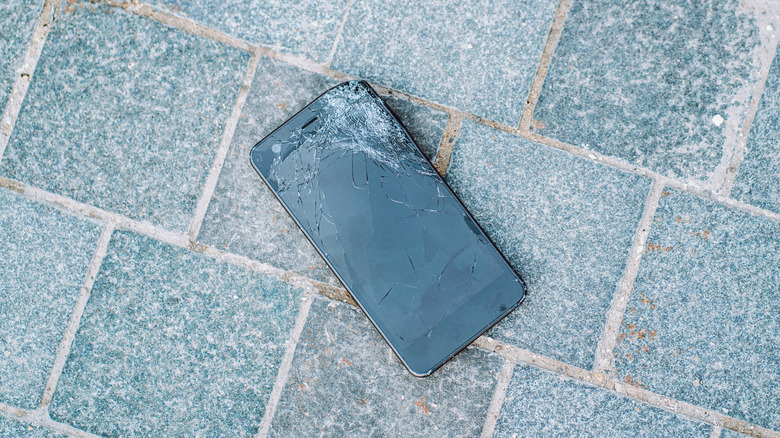What Does 'Military-Grade Drop Protection' Actually Mean On A Phone Case?
There was a time, around when Nokia's hardy 3410 was all the rage, that a phone was seemingly invincible. Today, the stakes are much higher, our devices perhaps less resilient, even if some unique phones are seemingly built to handle anything. With the amount that high-end smartphones cost today, it's little wonder that we want to safely clothe them in screen protectors and hefty cases. With regards to cases, military-grade drop protection is a phrase we often hear bandied about, and that sure sounds reassuring, but what does this actually mean?
Is it a phone case used by the military? Not specifically, but it has been subjected to some of the same testing. To qualify as a military-grade phone case, that case must fulfill testing requirements laid out by the Department of Defense. That is to say, it's not a vague boastful claim but a sign that the case in question meets or exceeds a specific set of exacting needs. Technology is dropped, shocked, dunked, and subjected to all manner of terrible treatment in the interest of safety testing, depending on that product's intended use and the risks it may face.
The protocol used to determine which cases are worthy of this prestigious distinction, when it comes to the drop test, is Method 516.6 Procedure IV (Transit Drop Test), in which it's repeatedly dropped from a height at different angles to test its all-around endurance. If you see that military-grade symbol on a piece of tech, you will typically assume that this means that particular case has been subjected to some rigorous standards and has surpassed them all. The fact is, though, the case may not be as hardy as is implied. This is because there are differing interpretations of the standards and how they can be achieved.
The MIL-STD-810G 516.6 Procedure IV (Transit Drop Test)
Method 516.6 Procedure IV (Transit Drop Test) is part of the wider MIL-STD (Miltary Standard) 810 series of shock tests. A case that was able to withstand a single impact from hitting the floor may not necessarily be able to do the same thing over time. Being MIL-STD-810G rated, for the Transit Drop Test, means that a phone case has been dropped from a height of four feet over two dozen times. Repeating the process 26 times dramatically reduces the risk of any 'fluke' successes, and helps to demonstrate that the case in question can withstand repeated drops. There are lots of accessories that can help keep our smartphones safe, and a good case is an important one.
A range of angles are used to see how the surface of the case as a whole holds up, because a case that was particularly weak in the corners or on the top or bottom would leave a phone vulnerable if it happened to land at such an angle. Otterbox declares that its Defender Series iPhone 15 Pro case is good for five times as many drops as this military standard requires. A vital thing to bear in mind is that regulations for passing these tests may be different depending on who's performing them and where. As Digital Trends noted in 2016, a manufacturer won't necessary drop the same model of a given case all 26 times, but can use a total of five over the course of the test. It's possible, then, for a variety of case to attain the military grade without one case from that line being able to survive every drop. Method 516.6, too, isn't the most recent version of this testing.
Potential limitations of the testing and the product you may buy
A phone case that simply declares itself 'military-grade' hasn't necessarily been through this test at all, and a cheap case may not be enough to protect your device. It can just be using the term as an advertising ploy. What you'll need to do is check the packaging or documentation to see if MIL-STD-810G testing, or the more recent MIL-STD-810H testing (the latest version of which having been updated with change notice 1 in 2022), has been performed. The latter is more stringent, dropping the item in question from a height of five feet and using concrete with a backing of steel rather than of plywood as the testing surface.
Even if a given case is listed as having been tested in this fashion, consumers can't know the specifics of how the testing was performed. A military grade phone case was not necessarily tested in a precise and uniform way by the military itself. In fact, the reality will typically be rather different. Tech21's global marketing director, Colin Woodward, explained to Digital Trends, while "the logos give the impression of independent testing," it's unfortunately true that "companies can conduct their own tests and therefore make their own claims." If four of the allowed samples of a specific phone case were essentially destroyed in the testing, and the fifth was just barely intact after the 26th drop was completed, it's possible that the manufacturer may have deemed that sufficient for a pass. The consumer, generally, is not privy to how this test was performed, nor the condition of the case was at the end of it. When choosing the right phone case for your taste and budget, then, the military grade logo may not be as significant a factor.


